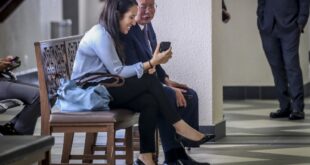The saga of the Huawei P30 phone that caused an international incident is over, for the moment. FedEx successfully delivered the controversial device from its origin in the UK to PCMag’s New York offices.
The phone, which arrived at 9:44 a.m. today, capped a weeklong adventure that began with our UK writer Adam Smith trying to send me a Huawei P30 Pro last week for benchmarking. The phone was turned around with an ominous label blaming U.S. government policy for the rejection.
Huawei is the subject of an extremely confusing ban currently affecting US companies exporting goods to Huawei offices abroad, as well as US telecom firms using Huawei hardware in their networks. The US Commerce Department seemingly delayed the ban for 90 days in May, and the White House Budget Office is reportedly seeking a longer reprieve, but the contradicting orders have sown confusion for shipping companies like FedEx and the UK’s Parcelforce, a unit of Royal Mail.
The offending label, which went minorly viral on Twitter, may have been added by FedEx, by Parcelforce, or by another handler in the chain. We still haven’t gotten a conclusive answer on that front.
This is totally ridiculous. Our UK writer tried to send us his @HuaweiMobile P30 unit so I could check something – not a new phone, our existing phone, already held by our company, just being sent between offices – and THIS happened @FedEx pic.twitter.com/sOaebiqfN6
— Sascha Segan (@saschasegan) June 21, 2019
We’ve created a handy timeline breaking down all the back-and-forth shipping, finger-pointing, and global outrage that has ensued.
The Phone Is Here
Smith dropped the phone off on June 24th with Parcelforce for “next day” service. On the morning of the 26th, a representative from Parcelforce called Smith and said the phone could not be shipped because of the blacklist and would be returned. PCMag then called Gary Simpson, the managing director of Parcelforce. After that, everything (finally) went smoothly.
The phone arrived today – two days later than Parcelforce’s “guaranteed” delivery date of June 25th. This seems to have been a Parcelforce rather than a FedEx problem. Once the device got into FedEx’s hands this time, it moved quickly.
It’s not clear if the device followed FedEx’s standard procedures. The company was certainly aware of exactly what phone this was, and where it was supposed to go. Local station manager Paul Harrison accompanied deliverywoman Shanta Stroud to make sure that the phone got into my hands, and the tracking information is a little odd. FedEx’s tracking data doesn’t show the package passing through one of the company’s freight hubs; it has no details between being picked up in London and being “on FedEx vehicle for delivery” in the US.

Both within FedEx and Parcelforce, individual lower-level employees appear to be panicking when confronted with the prospect of shipping Huawei products and turning them around, even if that isn’t corporate policy. That just seems to be par for the course right now, while everyone is confused about exactly what is banned and why.
PCMag’s part in this story may have finally concluded, but the ripple effects continue to spread. FedEx is currently suing the US Commerce Department, with a lawsuit stating that it should not be made to enforce export bans because they force FedEx to “police the contents of the packages it delivers” and invade Americans’ privacy. At the same time, President Trump is set to meet with Chinese leader Xi Jinping at the G20 summit in Japan to discuss several topics, including the ongoing trade war. We wonder if Huawei and FedEx will come up.

